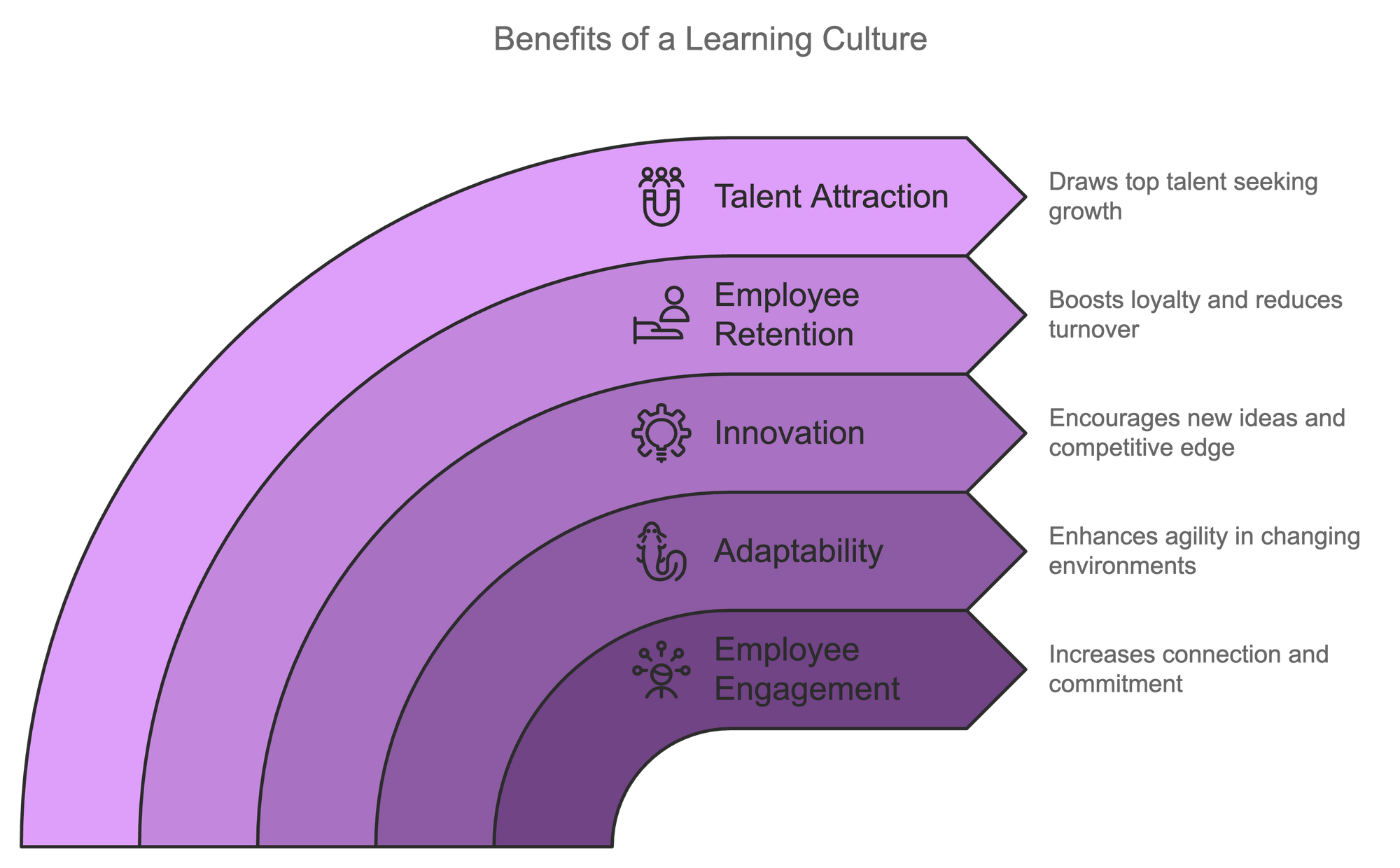Establishing a strong learning culture has become crucial for organizational success. A learning culture transforms how employees approach knowledge acquisition, skill development, and innovation within the workplace. When properly implemented, it becomes an integral part of your organization's DNA, driving continuous improvement and adaptability.
Creating a thriving learning culture is critical for the success of any organization today. A culture that prioritizes learning helps employees stay adaptable, engaged, and motivated, which ultimately boosts productivity and innovation. In this guide, we will explore what a learning culture is, why it matters, and how you can foster it effectively in your organization.
Key Sections:
- What is a Learning Culture?
- Why Learning Culture is Important to the Organization
- How to Create a Culture of Learning at Work
- Conducting a Culture of Learning with Technology
What is a Learning Culture?
A learning culture represents an organizational environment where acquiring and sharing knowledge is deeply embedded in daily operations. According to Deloitte, companies with a strong learning culture are 92% more likely to innovate and 52% more productive compared to those without such a culture (Deloitte, 2019). For a more in-depth understanding of how organizational culture plays a role, refer to The Ultimate Guide to Organizational Culture & Core Values.
A learning culture represents an organizational environment where acquiring and sharing knowledge is deeply embedded in daily operations. It is characterized by an ecosystem where employees consistently seek opportunities to develop new skills, share insights, and apply their learning to improve work processes.
This culture manifests through specific behavioral patterns: employees proactively identifying learning opportunities, leaders actively supporting skill development, and teams regularly engaging in knowledge-sharing activities. Unlike traditional workplace environments where learning is viewed as a discrete event, organizations with strong learning cultures integrate continuous education into their operational fabric.
A true learning culture allows individuals and teams to grow continuously, stay updated with new skills, and adapt to evolving challenges. Companies with such cultures empower their workforce to be innovative and proactive rather than reactive to changes in the market or their industry.
Why Learning Culture is Important to the Organization
Implementing a learning culture delivers multiple strategic advantages that directly impact organizational performance and sustainability. Research from LinkedIn's Workplace Learning Report (2021) indicates that 94% of employees would stay longer at a company if it invested in their learning and development. For more insights into improving employee engagement, read Boosting Employee Engagement: Modern Challenges and Winning Strategies.
Implementing a learning culture delivers multiple strategic advantages that directly impact organizational performance and sustainability.
- Improves Employee Engagement: When employees have opportunities to learn, they feel more connected to the organization. A Gallup study found that organizations with a strong focus on employee development see 17% higher employee engagement (Gallup, 2020). The chance to grow personally and professionally is a major driver of engagement.
- Facilitates Adaptability: In the face of rapid technological change and shifting market demands, organizations that invest in learning help their workforce remain agile and adaptable. A PwC survey found that 79% of CEOs are concerned about the availability of key skills, making adaptability crucial for business resilience (PwC, 2021). An adaptable workforce is better equipped to pivot when unexpected challenges arise.
- Fosters Innovation: A learning culture encourages employees to think outside of their usual roles and come up with new ideas. This can lead to fresh innovations that give companies a competitive advantage in the marketplace.
- Higher Employee Retention: Organizations with strong learning cultures see higher retention rates as employees feel more invested in their personal and professional growth. According to the Association for Talent Development (ATD), companies with comprehensive training programs have 218% higher income per employee and a 24% higher profit margin compared to those without formalized training (ATD, 2018).
- Enhanced Ability to Attract Talent: A company that is known for its learning culture is more attractive to top talent who value growth opportunities.

Moreover, learning cultures foster psychological safety, where employees feel comfortable taking calculated risks and learning from failures. This environment accelerates innovation and helps organizations maintain competitive advantages in rapidly evolving markets.
How to Create a Culture of Learning at Work
Establishing a learning culture requires deliberate strategy and consistent execution. To understand broader strategies for cultural change, see An Ultimate Guide to Culture Transformation.
Establishing a learning culture requires deliberate strategy and consistent execution. Here are some key approaches to build and maintain an effective learning culture:
- Lead by Example: Leaders should be the first to demonstrate the value of learning. When leaders openly engage in courses, webinars, or discussions about new insights, they model the behaviors they want to see. This encourages others to prioritize their development as well. Share personal learning experiences and allocate dedicated time and resources for learning activities.
- Create Structured Learning Opportunities: Make learning opportunities available to everyone. Consider implementing a learning management system (LMS) or regularly hosting workshops. Providing easy access to learning opportunities sends a clear message: growth and learning are organizational priorities. Implement formal mentorship programs, establish regular knowledge-sharing sessions, and develop clear career development pathways.
- Reward and Recognize Learning: Recognizing those who invest time in learning is a powerful motivator. Whether it’s a shout-out during a team meeting or a formal recognition program, celebrating the achievements of learners can reinforce the importance of continuous development. Include learning goals in performance evaluations and create incentives for knowledge sharing.
- Encourage Knowledge Sharing: Foster an environment where people feel comfortable sharing what they’ve learned. Creating forums for knowledge-sharing, such as internal blogs or lunch-and-learn sessions, allows employees to teach one another, multiplying the impact of individual learning efforts. Support communities of practice and encourage cross-functional projects for collaborative learning.
- Provide Resources and Time for Learning: If employees don’t have time for learning, a learning culture can never thrive. Set aside time in the workweek that’s dedicated solely to personal development. Providing resources, such as access to online courses or conferences, also demonstrates the organization’s commitment to growth. Normalize continuous feedback, establish regular feedback mechanisms, and encourage experimentation and learning from failures.
Conducting a Culture of Learning with Technology
Technology plays a pivotal role in scaling and sustaining learning cultures in modern organizations. For a closer look at how technology supports cultural transformation, refer to Digital Transformation and Culture Change: Overcoming Barriers to Achieve Success.
Technology plays a pivotal role in scaling and sustaining learning cultures in modern organizations. Digital learning platforms enable personalized learning paths, making education more accessible and engaging. Learning Management Systems (LMS) help track progress, while collaboration tools facilitate knowledge sharing across teams and locations.
Advanced analytics can identify skill gaps and learning preferences, enabling organizations to tailor their learning initiatives effectively. Virtual and augmented reality technologies are increasingly being used for immersive learning experiences, while artificial intelligence helps personalize learning recommendations and adapt content delivery to individual learning styles.
Technology also facilitates collaborative learning. Tools like intranet portals, digital whiteboards, and instant messaging platforms enable employees to connect and share knowledge in real-time, making learning an interactive and engaging experience.
Final Thoughts
Building a culture of learning at your workplace takes time and consistent effort, but the benefits to employee satisfaction, adaptability, and innovation make it well worth the investment. By integrating learning into the core of what your company does—and by using the right technological tools to facilitate growth—your organization can stay competitive and forward-thinking in today’s ever-evolving world.









